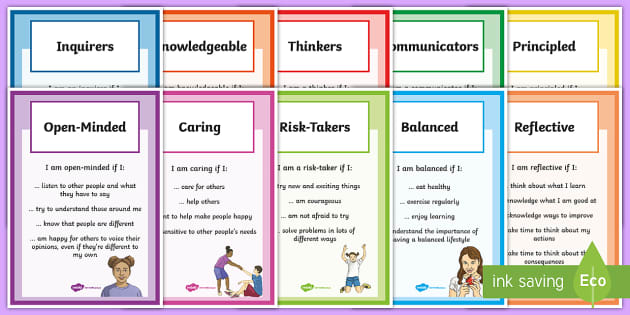

When I talked to next gen educators, they told me what was most important about learner profiles: that students get a chance to express themselves and know that people in their school are listening and truly want to know them. With learner profiles, students are invited to share a well-rounded picture of the gifts they bring to the classroom and explain what they need from their school, teacher, and others to help them be successful in their learning.
IB LEARNER PROFILES FULL
Learner profiles provide a space to gather information beyond student test scores and achievement data to create a full picture of a student. Personalized, student-centered learning aspires to do just that.įrom elementary school to high school, a learner profile is a way for students to describe themselves both as a person and as a learner. In his TED Talk “The Myth of Average,” Todd Rose advocates for a more flexible learning environment, one that rejects the notion of the “average student” and honors young people’s individuality-what he calls their “jagged profiles” of strengths and interests, as well as weaknesses. Profiles can also include character and leadership traits like gratitude, optimism, and self control or student work products, like a “personal best” portfolio. For example, Emily rattles off a list of just some of the information ReSchool’s Learner Advocates might collect about the children they serve: learning styles, what they are curious about, what motivates them, social-emotional needs, challenges, even the ideal noise level of the learning environment. According to Education Reimagined, a personalized learning approach also considers “such factors as the learner’s own passions, strengths, needs, family, culture, and community.” As a first step toward charting a student’s personalized pathway, the learner profile encourages a fuller understanding of who each child is. This is where the learner profile, sometimes called a learning profile, comes in. Unfortunately, in most schools, data on dimensions other than academic achievement do not pop into a teacher’s data dashboard or arrive in a digestible report from the district. Competencies that engage and develop learners into innovative problem-solvers and risk-takers who explore diverse points of view for ethical decision-making and positive impact, and other competencies as described in the NGLC MyWays Student Success Framework.

Valuable conversations about fragile or missing skills are taking place, informing decisions about student placement and interventions needed to support academic success.Įducators in next generation schools, however, are guided by broader definitions of success and a set of forward-thinking competencies-the knowledge, skills, and habits students will need not only to survive but to thrive as adults. At the start of a school year, educators in diverse school settings are examining student test scores and other achievement data to understand where students are relative to grade-level content standards. In the past our data about students has been narrowly defined. This statement by Emily Puetz, the learning architect at ReSchool Colorado, sounds a lot like common sense, but it is not as common as one might think.


 0 kommentar(er)
0 kommentar(er)
